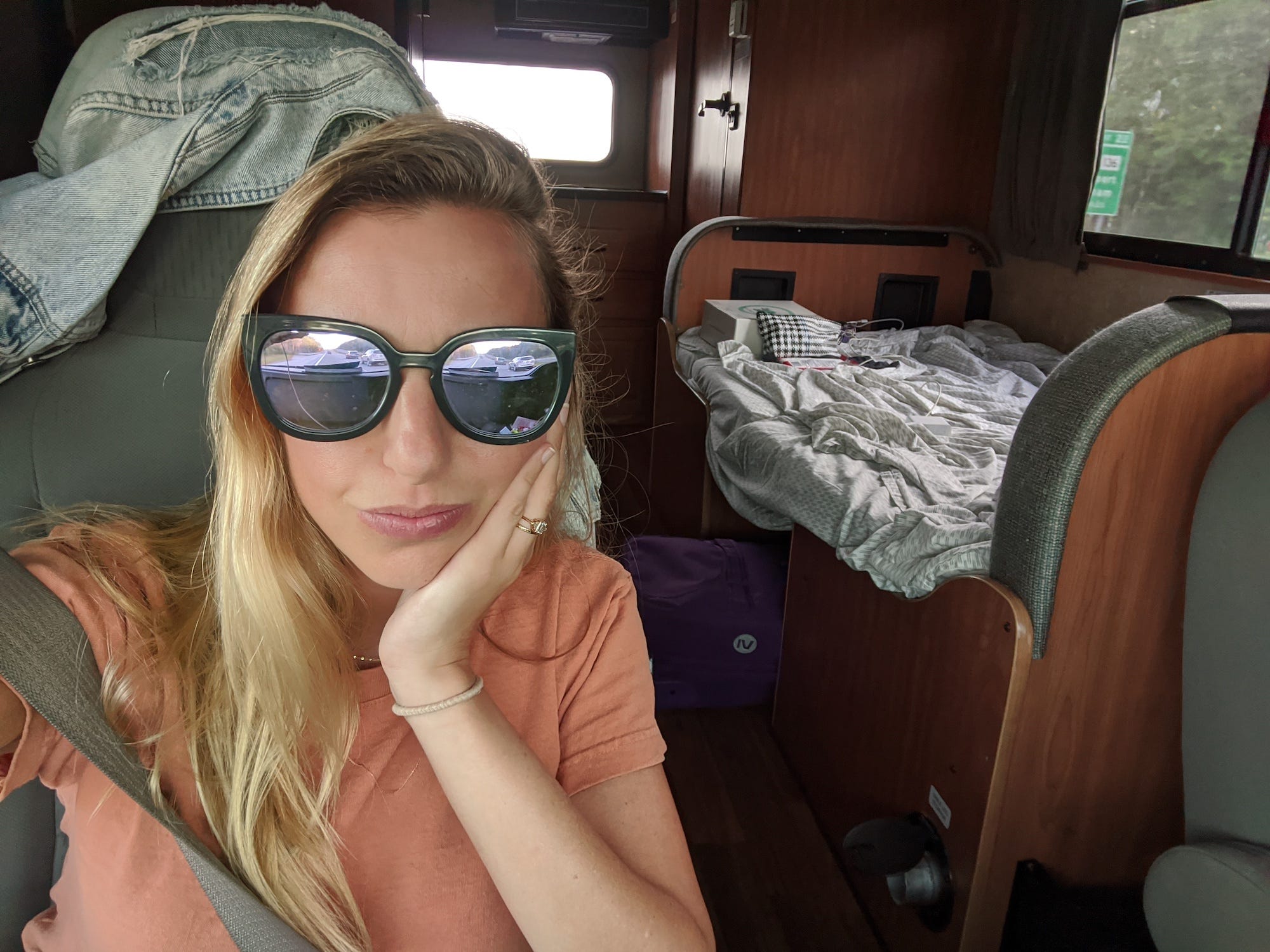
Sophie-Claire Hoeller/Insider
- I rented an RV for the first time on a recent trip from NYC to Maine.
- While it was a lot easier to drive and more user-friendly than I initially assumed, the RV’s size limits where you can drive and park.
- RV life was a lot more like camping than road tripping, which is what I assumed it would be like, and understanding this will affect how I pack and plan my route next time.
- For example, I would make sure to pack matches, candles or lamps for outside, and bug spray on my next RV trip.
- Visit Insider’s homepage for more stories.
RVs are so hot right now.
The coronavirus pandemic has turned 2020 into the year of the road trip, and tiny homes on wheels especially are more sought-after than ever. Many RVers I’ve spoken to lately have lamented how hard it is to find an affordable used RV these days, and RV rental companies have seen an enormous spike in bookings, as Business Insider’s Brittany Chang previously reported.
That’s because, amid travel bans, constantly changing rules, and looming second waves, exploring your own backyard seems like the smartest bet for travel right now.
Not just that, but RVs are also a uniquely safe way to travel in the current climate. Like a happy little snail, you have your own bathroom, your own kitchen, and your own bed wherever you go, thus minimizing the need to interact with others by going shopping, sleeping in hotels, or having to use public facilities while on the road.
In August, my friend Grant and I decided to see what RV life was all about by renting one and driving from New York City to Acadia National Park in Maine and back.
Neither of us had ever set foot in an RV before. And while it was a lot more like camping than we had both expected, we'd both 100% go on an RV trip again.
Renting the right RV for your needs is crucial for a successful trip

Sophie-Claire Hoeller/Insider
We spent a long time researching the right rig: The one thing we decided was that we wanted a bathroom with a door (we're close, but not that close), so that eliminated a van.
We also decided that, since we'd probably spend a lot of time outside, we didn't need a huge RV, and we were wary of getting one that was too unwieldy and difficult to drive.
That basically left us with Class C RVs.
The smallest one we could find that fit the bill was the "compact RV" from Cruise America, which was 20 feet long, 12 feet tall, and 7.5 feet wide. For reference, a Ford Expedition is 17.5 feet long, so it wasn't that much bigger than a large SUV. In fact, Grant, who did all the driving, said it drove much like one, and he took to it quickly.

Sophie-Claire Hoeller/Insider
Despite the RV's compact size, it was a lot more comfortable and spacious than I thought it would be. Grant slept in a queen-size bed above the driver's seat, and I slept in my own bed that converted from the dinette. While it's meant for kids, at 5'4" I fit comfortably.
We had a few issues with the shower: One quick shower flooded the entire bathroom, and we couldn't drain the water until we dumped the tanks.

Sophie-Claire Hoeller/Insider
Dumping the tanks was actually something I had been dreading, having read a plethora of RV stories featuring horrifying poo-related mishaps. However, it turned out to be super straightforward. That said, it was only two of us using the toilet, and we had only been in the RV for about 36 hours at that point, so I suspect our sewage tank was just not that full when we emptied it.
Figuring out RV life was a lot scarier in theory than in practice

Sophie-Claire Hoeller/Insider
Ahead of the trip, I was pretty nervous about figuring out all the things unique to RV-ing: How would we shower? How would we charge devices? How would we plug into water and electricity at campsites?
A very brief orientation by a rental agent when we picked up the RV did nothing to assuage my fears — in fact, they were stoked when the agent showed us an intimidating control panel full of colorful lights and matter-of-factly dropped advice such as "don't forget to turn off your fridge when you get gas or you might explode."
While a seasoned RV-er wouldn't bat an eyelash at this, for us newbs this was frightening information.
Nothing short of terrified we took off… Only to almost lop the top of the RV off 20 minutes later, when we went through a too-low overpass that had a clearance of under 10 feet — our RV was 12 feet.
However, that little hiccup (and the aforementioned shower-flooding incident) was really the only issue we faced. RV life was a lot more straightforward than we expected, and hooking up to electricity and water at campgrounds is not a whole lot more difficult than plugging a device in to charge.
RV-ing is more like camping than road tripping

Sophie-Claire Hoeller/Insider
All in all, we had a great time. We were surprised by how much RV-ing is like camping, but in the best possible way: At campsites, you get your own little lot, in our experience always with a picnic table and fire pit; you spend almost all of your time outside; you need to think through all sorts of scenarios and pack everything you could possibly need.
Unlike camping, you don't have to sleep on the floor or set up camp from scratch every time. You park, you plug in, and you're ready. Plus, you don't have to use the campsite's shared facilities. Many RVs we saw at campsites were decked out with full-on patios filled with décor, grills, second fridges, comfy couches, lights, even gazebos.
That said, because we didn't realize that our trip would be more like camping than staying in a house that happened to be mobile, we were ill-prepared on day one and hadn't packed anything to make being outside at night more comfortable.
I've done a lot of camping in my day and congratulated myself on thinking to pack toilet paper, dish soap and a sponge, paper towels, and a gallon of distilled water. But I did not think to bring matches to start the stove or to make a fire, or to bring lights, candles, or bug spray.

Sophie-Claire Hoeller/Insider
That was a lesson we learned early on: You need a lot of stuff for RV life, just like for camping. You need kitchenware, sheets, pillows, towels, water, cleaning supplies, food provisions, etc., as well as clothes for all types of weather. And you don't have a whole lot of space to store it all in.
Grant and I also treated this road trip too much like one taken with a regular car, planning stops along the way, thinking we could just bop around easily.

Sophie-Claire Hoeller/Insider
Turns out, not everywhere is RV-friendly, and it can be very difficult to find parking.
Driving such a big vehicle can be quite limiting in where you can go. Not all parking lots allow RVs, not even ones that you pay for, and that can be a deterrent to driving into a city for a quick lunch or stroll.
Not even all national parks, with their narrow, winding roads and antiquated infrastructure, will be RV-friendly. While we wanted to see the sunrise from Mount Cadillac in Acadia National Park, we couldn't drive there with the RV — even though it's one of the smallest motorhomes you can get.
Costs are worth considering ahead of time
While we paid $225 a night for the rental RV, other fees, from mileage to gas, added up to a pretty expensive five-day vacay. We spent almost $2,000 on gas, tolls, and the RV rental alone.
Next time I rent an RV (and there will be a next time!) I'll treat it a lot more like a camping trip than a road trip, and prepare accordingly in terms of my packing list and route.
- Read more:
- 21 surprising things I learned from taking a road trip in an RV for the first time
- 14 common mistakes to avoid when renting an RV, from someone who just did it for the first time
- Renting an RV was far more expensive than I thought it would be. Here are 15 costs to consider before you book.
- I took a 1,000-mile road trip in a 150-square-foot RV, where no space was left unused. Take a look inside.
- Renting an RV during a pandemic showed me how road trips are different right now. Here's what to expect before you go.

